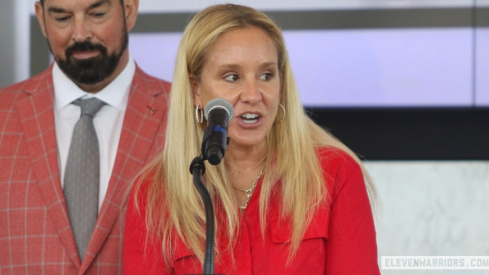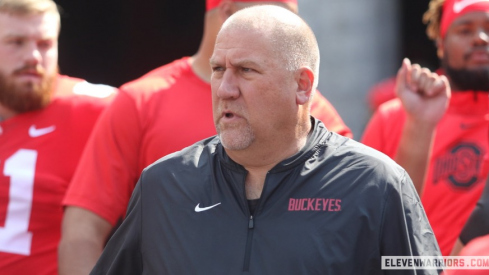Suppose you are an Ohio State team that is ranked #4 in the country and you are about to start the Big Ten season with a home game. You are coming off two impressive out-of-conference wins and your margin of victory in both games was in double digits. You would probably feel pretty good about your chances, right? Well, in 1968 this was the case and yet the Buckeyes were 13-point underdogs going into the game. The reason is that the team they were playing was #1 ranked Purdue.
 Kern: Hall of Fame material
Kern: Hall of Fame material (www.ohiostatebuckeyes.com)
Purdue had started the season at the top of the rankings, and there was good reason for that. Their offense was led by All-American quarterback Mike Phipps and two-way halfback Leroy Keyes. They also had powerful offensive and defensive lines. Purdue had come to Columbus the previous season and slaughtered the Buckeyes 41-6.
That loss was one of many in the last two seasons. During a span from 1966 to 1967, Ohio State had lost 8 out of 13 games including 4 straight at home. Coach Woody Hayes was under fire for the first time since the early 50's. Critics were bringing out the now-familiar line about how "the game has passed him by" and planes were circling the stadium with banners saying "Bye Bye Woody". He was even being hung in effigy on trees in the campus area.
But Ohio State regrouped and finished the 1967 season by winning their last 5 games, including a 24-14 win over Michigan. Meanwhile, Hayes' latest recruiting class was very highly regarded, and they would be expected to contribute mightily to the team when they became eligible to play as sophomores in 1968. The "Super Sophs" included starting QB Rex Kern, backs Leo Hayden, Larry Zelina, and John Brockington, and ends Jan White and Bruce Jankowski on offense. Defensively, DB's Jack Tatum, Mike Sensibaugh, and Tim Anderson became instant starters along with nose-tackle Jim Stillwagon. After taking care of business in their first two games, the Buckeyes were itching to get a measure of revenge over Purdue for the previous season's humiliation.
The strong recruiting was to be a god-send for the program. Hayes had struggled for years to recruit the best in-state players after what happened in 1961. That year, Ohio State had gone undefeated (with a 7-7 tie against TCU in the opener) and had crushed their arch-rival Michigan by a score of 50-20. They were outright Big Ten champions and were invited to go to the Rose Bowl to face a UCLA team they had already beaten earlier in the season. But the OSU faculty council voted to not accept the invitation because of concerns that the football team was becoming larger than the university, and that academics would suffer as a result. Fans were outraged, the Columbus Dispatch printed the names and addresses of the men who voted not to go, and Hayes needled them publicly stating "I don't agree with those 28 ‘no' votes, but I respect the integrity of the men who cast them, if not their intelligence."
For years afterward, opposing coaches used that incident against Ohio State on the recruiting trail, which made it difficult to convince the best Ohio players to stay home and attend OSU. So eventually Hayes decided that he needed to do more national recruiting to supplement the Ohio players, and the culmination of those efforts was the class of '67. Of course, in those days freshmen were not eligible to play on the varsity team, so they would have to wait for their sophomore year to get on the field for the Buckeyes. But once there, they made the most of it, winning 27 out of 29 games in their 3 years of eligibility. But their first big challenge was the top-ranked Boilermakers in the Big Ten opener.
To start the game, OSU took over after receiving the kickoff and immediately started running a no-huddle offense. Hayes had felt that the Purdue linemen were slow and out of shape, so he wanted the offense to move at a quck pace to keep them moving. They would call three plays in the initial huddle and then run them consecutively without huddling. On the first drive, the Buckeyes moved relentlessly down the field as Brockington repeatedly gashed the Purdue defense with his hard running style. But the drive stalled at the Purdue 4-yard line, and then OSU missed the field goal. Other drives in the first half would end in similar fashion, but the defense was giving Purdue all they could handle. Tatum focused on stopping Keyes and wherever the star halfback tried to go, "The Assassin" was waiting for him.
 Tatum was not afraid to lay the wood.
Tatum was not afraid to lay the wood. (www.art.com)
The entire first half was a defensive struggle that ended in a 0-0 tie. OSU had controlled the tempo and had numerous opportunities, but they were unable to punch it in or even convert a field goal. But the Buckeyes were much more opportunistic in the second half. Purdue started with the ball, but on their 4th play from scrimmage Phipps would make a critical error. The previous play, Tatum had jumped an out pattern and nearly intercepted the ball. On the next play, Tatum and fellow DB Ted Provost switched assignments, and Phipps read it as a change in coverage. He attempted the same out pattern as before, but this time Provost jumped the route and made the interception. He returned it 35 yards for the touchdown and Ohio State was suddenly holding a 6-0 lead (after a missed PAT).
Later that same quarter, Phipps would compound his error with another interception as the future Cleveland Browns QB would be picked by Stillwagon. Unfortunately for the Buckeyes, Rex Kern would be injured on a QB keeper to the right sideline, thus forcing Hayes to go with little-used senior backup Bill Long. Ohio State had the ball at the Purdue 14-yard line, and Hayes had always been averse to passing. But he crossed up the defense by calling a pass play. Seeing all of his options covered, Long tucked the ball and ran through the confused defense and into the end zone. After the successful PAT kick, OSU held a 13-0 lead. The defense continued to thwart the Boilermakers on offense, and Ohio State held on for an improbable 13-0 victory.
Purdue went on to finish 8-2, losing on the road at Minnesota. Phipps, Keyes, and middle-guard Chuck Kyle were consensus All-Americans, with Keyes finishing 2nd to Simpson in the Heisman Trophy voting. Keyes was selected in the first round of the NFL draft by the Philadelphia Eagles, but his pro career never measured up to his college exploits. Phipps repeated the All-American honors a year later, finishing 2nd in the Heisman race to Oklahoma's Steve Owens. Phipps was also chosen in the first round of the draft, but the pick was controversial because the Browns traded former Ohio State receiver Paul Warfield for the rights to take him. Phipps had a few good seasons in Cleveland, but he was ultimately beat out by Brian Sipe and traded to Chicago, where his career ended a few years later.
The win became the springboard for OSU's national championship run. They closed the regular season with another annihilation of That School Up North by a score of 50-14. Woody Hayes famously called for a 2-point conversion after the last touchdown just so the team would get to 50 points. According to legend, Hayes said afterward when asked why he went for 2 "Because we coudn't go for 3" (the veracity of the story has been questioned, but Lou Holtz maintains that Hayes actually did say it, and who are we to argue?). The undefeated season earned a Rose Bowl trip, and Kern led the Buckeyes to a come-from-behind victory over O.J. Simpson and the USC Trojans, 27-16. Kern also met his future wife on the trip, which added to his legend. After the victory, Ohio State was named national champs by both wire services. Many years later, Kern stood in the Fiesta Bowl post-game press room and publicly congratulated Craig Krenzel and the 2002 Ohio State team for winning a national championship of their own. It was OSU's first championship since 1968, and like the previous one it had turned the corner after a win over Purdue. As the French say, plus ça change, plus c'est la même chose.

